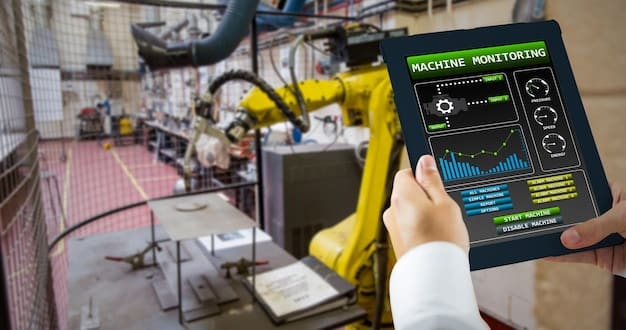AI-Driven Energy Management: Cut Costs by 10% for US Businesses

AI-driven energy management optimizes energy consumption in US businesses, leveraging machine learning algorithms to analyze usage patterns, predict demand, and automate adjustments, resulting in potential cost reductions of up to 10%.
Is your US business looking to slash energy costs while boosting sustainability? Discover how AI-driven energy management is revolutionizing energy consumption, paving the way for significant savings.
Understanding AI-Driven Energy Management
AI-driven energy management is transforming how US businesses approach energy consumption. It’s not just about turning off the lights; it’s a holistic, data-driven approach to optimizing energy usage across the board.
This section will delve into the core concepts of AI in energy management and why it’s becoming increasingly essential for businesses in the US.
What is AI in Energy Management?
At its heart, AI in energy management involves using machine learning algorithms to analyze energy data and make intelligent decisions. This includes predicting energy demand, identifying areas of waste, and automatically adjusting systems to optimize performance.
The Benefits of AI for Energy Efficiency
The benefits of adopting AI for energy management are vast, ranging from significant cost savings to enhanced sustainability and improved operational efficiency. AI provides the insights and automation needed to take energy management to the next level.
- Cost Reduction: AI can identify and eliminate energy waste, leading to substantial cost savings.
- Sustainability: By optimizing energy consumption, AI helps businesses reduce their carbon footprint.
- Improved Efficiency: AI automates energy management, freeing up staff to focus on other tasks.
- Data-Driven Decisions: AI provides real-time data and insights, enabling informed decision-making on energy-related matters.
In summary, AI-driven energy management offers a powerful toolset for US businesses aiming to optimize their energy usage, reduce costs, and contribute to a more sustainable future.
Key Components of an AI Energy Management System
An effective AI energy management system isn’t just a piece of software; it’s a comprehensive solution comprising several key components working together seamlessly. Understanding these components is crucial for implementing a successful system.
This section will break down the essential elements of an AI energy management system and explain how they contribute to its overall effectiveness.

Data Collection and Sensors
The foundation of any AI energy management system is accurate and comprehensive data. This is gathered through a network of sensors and meters strategically placed throughout a building or facility.
AI Algorithms and Machine Learning
The real magic happens with the AI algorithms and machine learning models that analyze the collected data. These algorithms identify patterns, predict future energy demand, and recommend optimal settings.
Consider these aspects of AI algorithms:
- Predictive analytics: Forecasts energy consumption based on historical data and external factors.
- Anomaly detection: Identifies unusual energy usage patterns that may indicate inefficiencies or equipment malfunctions.
- Optimization algorithms: Determines the most efficient settings for HVAC, lighting, and other systems.
By integrating these key components, an AI energy management system can provide US businesses with the insights and automation needed to significantly reduce energy consumption and costs.
Real-World Applications of AI in Energy Management
AI-driven energy management isn’t just a theoretical concept; it’s already being applied in various real-world settings, delivering tangible results for US businesses.
This section will showcase some practical applications of AI in energy management across different industries and building types.
Smart Buildings and HVAC Systems
One of the most common applications of AI in energy management is in smart buildings, where AI algorithms optimize the performance of HVAC systems based on occupancy patterns and weather conditions.
Manufacturing Plants and Industrial Processes
Manufacturing plants are another area where AI can have a significant impact on energy consumption. AI can analyze industrial processes and identify opportunities to optimize energy usage.

Areas of focus:
- Predictive maintenance: Prevents equipment failures that can lead to energy waste.
- Process optimization: Identifies inefficiencies in industrial processes and recommends improvements.
- Demand response: Adjusts energy consumption based on grid conditions and pricing signals.
These real-world applications demonstrate the versatility and effectiveness of AI in energy management, highlighting its potential to deliver significant cost savings and sustainability benefits for US businesses.
Case Studies: US Businesses Saving with AI
While the potential of AI-driven energy management is clear, seeing real-world examples of success can provide further validation and inspiration.
This section will present case studies of US businesses that have successfully implemented AI in their energy management strategies, achieving significant results.
Case Study 1: Commercial Office Building
A large commercial office building in New York City implemented an AI energy management system that optimized HVAC and lighting based on occupancy patterns and weather forecasts. This resulted in a 15% reduction in energy consumption and a significant decrease in utility costs.
Case Study 2: Manufacturing Plant
A manufacturing plant in the Midwest implemented an AI system that analyzed industrial processes and equipment performance. The system identified several opportunities to optimize energy usage, resulting in a 12% reduction in energy consumption and improved productivity.
Insights from these case studies:
- Data is key: Accurate and comprehensive data is essential for AI to effectively analyze and optimize energy consumption.
- Customization is important: AI energy management systems should be tailored to the specific needs and characteristics of each business.
- Ongoing monitoring is crucial: Continuous monitoring and analysis are necessary to maintain optimal performance and identify new opportunities for improvement.
These case studies demonstrate that AI-driven energy management is not just a future trend, but a viable and effective solution for US businesses looking to save money and reduce their environmental impact.
Overcoming Challenges in AI Energy Management Implementation
While the benefits of AI-driven energy management are undeniable, implementing such a system can present several challenges.
This section will address some of the common obstacles that US businesses may encounter during the implementation process and offer strategies for overcoming them.
Data Integration and Quality
One of the biggest challenges is integrating data from different sources and ensuring its quality. Data silos, inconsistent formats, and inaccurate measurements can all hinder the effectiveness of AI algorithms.
Lack of Expertise
Implementing and managing an AI energy management system requires specialized expertise in areas such as data science, machine learning, and energy engineering. Many businesses may lack the in-house talent to handle these tasks.
Tips for overcoming these challenges:
- Invest in data infrastructure: Implement a robust data management system to ensure data quality and accessibility.
- Partner with experts: Collaborate with experienced AI energy management providers or consultants.
- Start small and scale up: Begin with a pilot project to test the waters and gradually expand the system.
By addressing these challenges proactively, US businesses can increase their chances of successfully implementing AI-driven energy management and realizing its full potential.
The Future of AI and Energy Efficiency
AI is poised to play an increasingly significant role in shaping the future of energy efficiency. As AI technology continues to advance, we can expect even more innovative and impactful applications in energy management.
This section will explore some of the emerging trends and future possibilities in the realm of AI and energy efficiency.
Edge Computing and Decentralized Control
Edge computing, which involves processing data closer to the source, can enable faster and more responsive AI energy management systems. Decentralized control strategies can also improve resilience and flexibility.
Integration with Renewable Energy Sources
AI can play a crucial role in integrating renewable energy sources, such as solar and wind, into the grid. AI algorithms can predict energy production and optimize distribution.
Future possibilities:
- Self-learning buildings: Buildings that continuously learn and adapt to optimize energy consumption.
- AI-powered energy storage: AI algorithms that optimize the charging and discharging of energy storage systems.
- Personalized energy management: AI systems that tailor energy consumption to individual preferences and needs.
In conclusion, the future of AI and energy efficiency is bright, with endless possibilities for innovation and improvement and US businesses can be at the forefront of driving this transformation.
| Key Point | Brief Description |
|---|---|
| 💡 AI Energy Management | Optimizes energy use via machine learning, cutting costs. |
| 📊 Data & Sensors | Collect key consumption data for AI analysis. |
| 🏢 Smart Buildings | Optimize HVAC and lighting in commercial spaces. |
| 🌱 Sustainability | Helps businesses reduce their carbon footprint. |
FAQ
▼
AI-driven energy management utilizes machine learning to optimize energy consumption in buildings and industries. It analyzes data to predict usage and automate adjustments.
▼
AI reduces costs by identifying inefficiencies, predicting energy demand, and automating adjustments to HVAC, lighting, and other systems. It eliminates waste.
▼
Key components include data collection via sensors, AI algorithms for analysis, and automated control systems for making adjustments based on the insights.
▼
Industries like manufacturing, commercial real estate, and healthcare benefit significantly due to their high energy consumption and complex operational needs. AI optimizes resource use.
▼
Businesses can start by assessing their energy usage, investing in data collection infrastructure, and partnering with AI energy management experts for system implementation and support.
Conclusion
In conclusion, AI-driven energy management offers a transformative approach for US businesses aiming to optimize energy consumption, reduce costs, and enhance sustainability, making it an essential strategy for future success.





